Student Grade Checks and Accountability
About three years ago, my student teacher and I decided to implement a weekly grade check with our class. It has since evolved.
First, the “West Wing” (i.e. Intervention hallway) adopted this procedure to be completed in Core Plus More on Mondays.
Last year, 36 grade check sheets were added to the back of the student agenda and it became a school-wide project.
I made a few adjustments based on student and teacher feedback, and we are rolling out a new and improved version in the student agendas this year.
First, let me show you the cover of the agenda, because it is ADORABLE.
Next, a shot of the entire grade sheet along with a PDF for you to download.
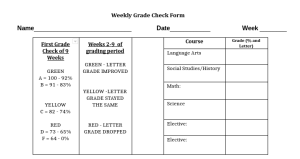
The top half is where they login to Progress Book and record their grades (as well as color code.) This helps them visually notice progress or a downward trend.

This part is a little more challenging, because it requires students to go through each subject and look for M’s for missing work or L’s for late work. They also have to read teacher comments such as, “Needs to retake this quiz.”
Our Building Leadership Team decided we should purposefully instruct the students on how to do this grade check the first few weeks of school. It is definitely a learning curve to this, especially for our 6th graders. In general, many students struggle with the goal setting as well.
I created a Google Slide show for the staff which they can share in their Tornado Times (which is when grade checks are done.) Usually this is done on a Monday so that they have the week to work towards completing missing work. I’ll attach a PDF of the slide show as well.
Some highlights first:
This process, while time-consuming, especially at the beginning of the year, has been well-received by our staff and students. Check out the links below for FREE downloads.
18-19 Agenda Book Grade Check Recording Sheet
Do you have a similar activity in your classroom or building?
What goes well? What needs to improve?
I’d love to hear your ideas. Leave a comment.
2018 First Day of School Scavenger Hunt
Viral videos and big moves in the NBA have led me to change up my scavenger hunt for the first day of school. Click the link: 2018 Classmate Scavenger Hunt for the PDF. See the links below for other versions of this activity.
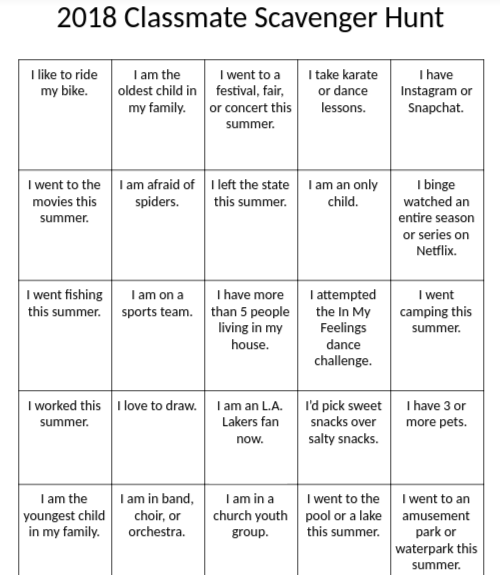
The Kindness Bug
Be kind.
I know it’s a popular expression lately, but there’s nothing wrong with that.
The more people who say it, believe it, do it….the better, right?
Maybe it’s because of the constant school violence and threats of violence.
Maybe it’s because of the increasing number of teen suicides my area of the state has seen.
Maybe it’s because I finally saw the movie, Wonder, last weekend.
Maybe it’s because I am trying really hard in some areas of my life to show extra kindness.
It could be a combination.
It doesn’t matter why. Do I need a reason to remind my students to be kind?
This week I decided to put a quote in place of the typical school events on the white board each day. 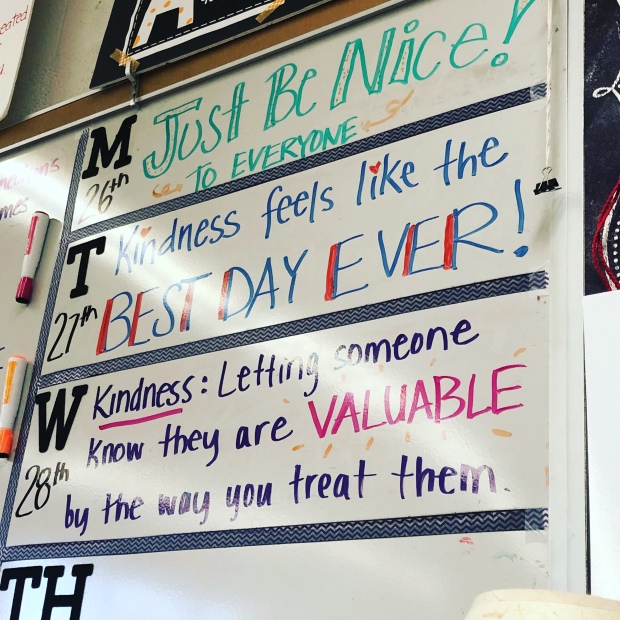
My 2nd period class gets 15 minutes to 1) copy the quote in their agenda (instead of homework this week) and 2) respond to the quote in their journals.
Some students have chosen to share what they’ve written. I hope by the end of the week everyone will share at least one journal entry.
This afternoon I asked my hallway custodian, who is an incredible example of KIND, to give me the quote for tomorrow. She was so happy I asked her.
I’ve opened Thursday and Friday’s slots up to my Instagram followers.
What’s your favorite kindness quote?
Do you have a good theme for next week?
Leave a comment. I’d love to share your idea with my class.
Owning Our Mistakes
My 7th graders got an earful from me today (in the nicest way possible).
- They really need to stop starting every sentence with the word so.
- They also really need to stop starting every other sentence with and, then, or but.
- They also really need to stop starting every sentence with I.
- They can always make their writing better.
My goal: To help students identify ways to improve their own writing by using actual anonymous samples from their latest creative writing pieces.

As I was reading their writing from the other day, I noticed some trends in the types of mistakes they were making in sentence structure and overall style. (Obviously those mistakes have already been pointed out above in #1-3.)
We spent about 25 minutes practicing ways to improve their writing by eliminating those three problems.
I included random lines from their samples – with the intent of making the task authentic and relevant. I told them it was not to make fun of anyone, but to show them that there are ways they can all make their writing better.
(That’s a rule of mine. They cannot say, “I’m done” or “Is this good?” when they are writing. They must ask “How can I makes this better?”)
Through some revision practice on the Smartboard and their dry erase boards, I reminded them of the rules they’ve learned this year in LA 7: subordinating conjunctions, FANBOYS, simple, compound, and complex sentences, phrases, and clauses.
Before we moved onto their next task – to write another piece avoiding those three no-nos we listed above – I passed out their papers and had them analyze their mistakes.
I asked them to reflect and identify their biggest writing problem. I also wanted them to come up with a solution or strategy to make their writing better.
Here are a few examples of their reflections:
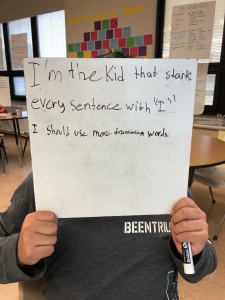

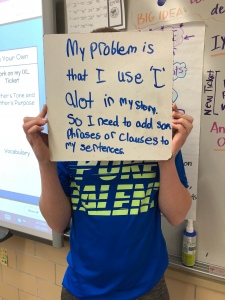
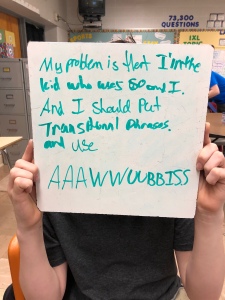
I am anxious to read their new writing assignment. Hopefully, today’s lesson was effective.
One of the boys did say to me as he walked out at the end of class, “You are going to love my story. It is SOOOOO good. I mean, it’s…it’s…it’s…amazing. SOOOOO amazing!”
He laughed all the way out the door.
Do You Bitmoji?
I use Bitmoji in approximately four ways:
1) To participate in group holiday texts with my family 
2) To tell my kids goodnight if they are at their dad’s house 
3) To express sarcasm, enthusiasm, or exhaustion with my colleagues (don’t we all?)
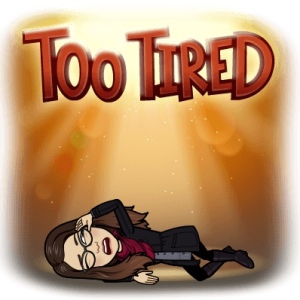
4) To get my students attention (This either makes them laugh or makes their eyes roll.) 
I’ve seen a lot of teachers customize the expressions and phrases to fit their classroom.
Instead of getting out of bed and starting the laundry, I decided to do likewise. 
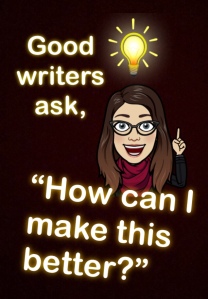



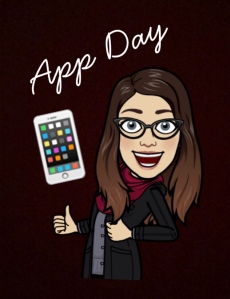
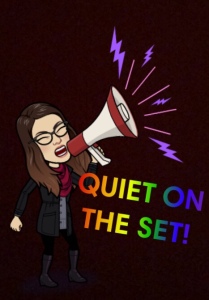
Going for the IXL Gold
So yesterday I was sick in bed and an idea came to me as I went in and out of sleep.
I decided to create the IXL Olympic Games.
I created two podium slides for each class period for two different areas: the time students spent on IXL and the number of skills students have shown progress on in February.
The kids simply went wild for this silly idea, as you can see below.

We will wrap up the competition on February 28th. Right now, it’s anybody’s game!
Tell me about a silly spur-of-the-moment idea that was well received by your students. I’d love to hear from you.
Managing the Differentiation of IXL Assignments in My Classroom
I’ve tried several ways to assign IXL so that the assignments are appropriate and differentiated.
(If I were using IXL for math, I could have students use the Recommended Lessons on the Math Diagnostic, but that isn’t an option for Language Arts.)
I’ve found a good way to assign a series of lessons on a given topic that will meet the needs of my students who range from Beginning Reader to Lexiles in the 1100s.
These tiny IXL tickets get stapled into the student’s agenda books so they have the sequence of lessons with them at all times. Students mark off each lesson they complete, and then I meet with them near the due date (typically two weeks) to check their progress and award stickers for their iPhones.
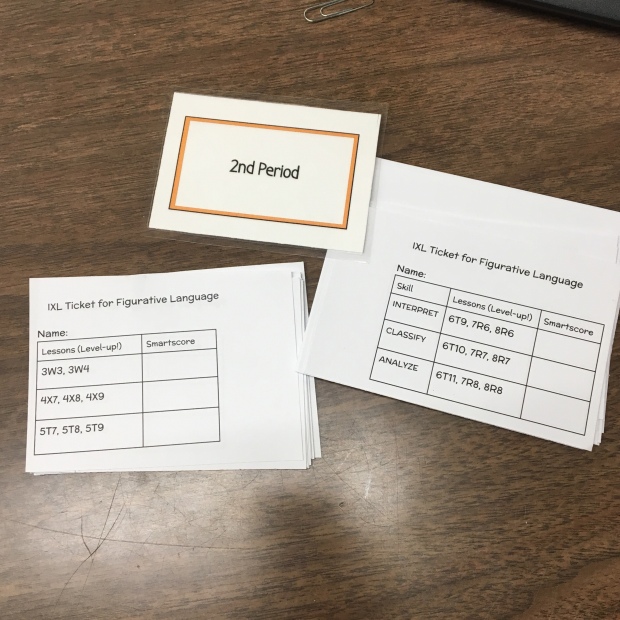
Below are the PDF versions of the IXL Tickets I’ve used in class most recently. I plan on going back and tweaking some from earlier in the year.
When you take a look at these files, you will see they cover different grade levels and sequences depending on the skills.
Students have the option of working horizontally or vertically on some tickets, finding just the right place for them. As always, I encourage them to “Level Up!” when they can.
IXL Ticket Author’s Tone and Purpose
IXL Ticket Figurative Language
IXL Ticket Compare and Contrast Text 6-8
IXL Bulletin Board
As promised, here is the first of several IXL related posts.
This is how I highlight the skills we are working on for the week…or two weeks…or month…depending on how many snow days we have!
The board is divided for my three different classes: a 7th grade class, an 8th grade class, and my C+M stands for “Core Plus More” which is our part of our Intervention program.
We are often studying different things at different times so the charts get moved around quite often. (Many of my anchor charts are Pinterest inspired.)
The “73,300 Questions” above the board shows how many Language Arts questions my five classes have answered collectively since the beginning of the school year.
The “Target > 85” refers to their SmartScore.
The SmartScore is a hot topic in our building right now. What is fair? What is reasonable? What is realistic?
I went to the IXL FAQs and found that a SmartScore of 80 is considered “good,” 90 is “excellent,” and 100 is “mastered.”
I chose 85 because it seemed to be a good challenge for the students I work with.
At times I will tell a student to work towards a lower SmartScore if they are truly working hard and still struggling.
I also encourage students to “Level Up,” meaning if they are working at the 5th grade level and hit 85, the should Level Up – I tend to make a silly video game noise when I say this- and try the related 6th grade skill. (More on that later).
Of course, I’ve had students ask, “Can I get higher than 85?”
Without a doubt- go for it!

Blog Series: IXL in My Classroom
Last year, one of my coworkers kept talking about what I heard her says as “I Excel,” an online learning program she signed up for using one email, then another, then another…as her free 30-day trials ran out.
Seeing as I gave her my email to use at one point, and tending to shy away from things like this, (why, I don’t know!?) I never got on board.
I mean, I was already using Kahoot, Padlet, Quizlet, Quizizz, Skills Navigator, Schoology, and had just started using Google Classroom. Did I really need another reason for my class to be on the Chromebooks?
Things changed this year when our building was able to buy the full features of the Math and Language Arts curriculum with our 21st Century Grant.
Now I have incorporated IXL into my classroom, as have many teachers in the building.
The big questions though…
- How should we use it?
- How much is too much?
- What should we expect from students?
- Should it be graded?
- Should it be homework?
- How can we keep it fresh?
While this page has lots of inspiration for using IXL, I thought over the next several posts I would share a few of the ways I use IXL in my classroom that seem to be effective, and tell you some of the things that haven’t seemed to work.
Just look at the progress we’ve made so far!

This graphic represents 111 students I work with throughout the day, including some who are part of our after school program. It includes ELL students just starting to speak English, IEP students working several grades below grade level, and students working at grade level. This chart represents only the Language Arts topics. NOTE: October had the most actual “school days” due to holidays and weather. (I had to think about this because I was shocked to see how the numbers dropped off as we moved through the months.)
Do you use IXL?
What are your favorite strategies and methods?
What motivates your students?
What questions do you have?
Please share your ideas, thoughts, and questions in the comments.
Reading Folks
My 7th grade Language Arts students will be starting the novel, Seedfolks by Paul Feischman this week.
I really wanted to do something different, like my Literature Circles. However, I only have 8 students in this intervention class, and I knew I needed to make some modifications for something like this to work this year.
This new collection of Seedfolks Chapter Worksheets has 13 graphic organizers (all the same, but labeled with each character’s name.)

I plan on completing the first few together, and then have them work with a partner or group on others. At some point near the end of the novel, they will do one on their own for a grade.
I also made 8 different pages that look like this:

Each page will ask the students to list three character traits, which is a review from earlier in the year. Also, on each page, the students will have to ask one question, as if they were talking to the character in the chapter. I’m excited to see what they come up with for this box! The box across the bottom and the box on the right-hand side are different on each of the eight pages, covering a variety of reading skills including:
- Inferring
- Visualizing
- Characters
- Making Connections
- Author’s Craft
- Asking Questions
- Reflection
- Evaluating Text
My plan will be to pass a different one out to each student at the start of the chapter, and then we will discuss in a literature circle type fashion.
Seedfolks is based on the concept of individuals coming together to create a community garden. My lessons will be based on the concept of a community of readers.
I may just call them my “Readfolks. “


